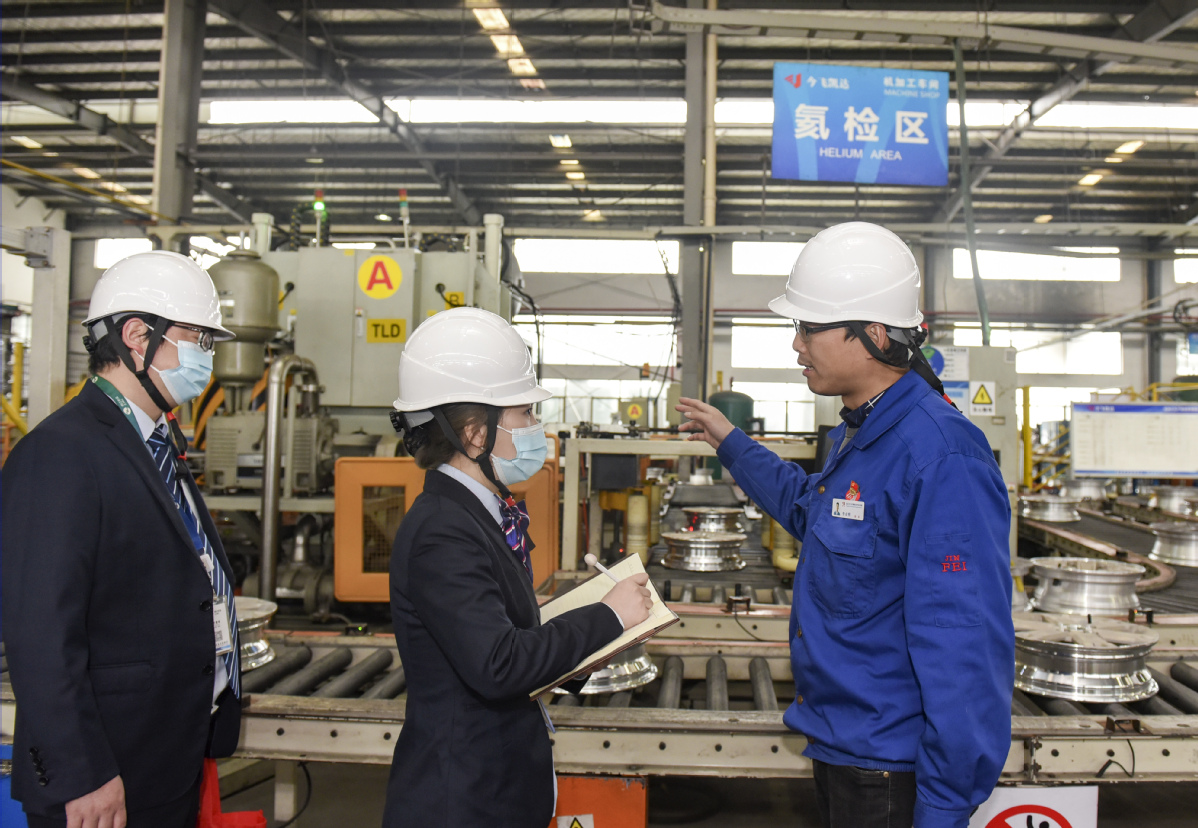
A worker (right) of an auto-part SME answers queries from bank employees on production at a facility in Jinhua, Zhejiang province, in March. [Photo by Li Jianlin/For China Daily]
Light at the end of tunnel
In spring 2020, many smaller businesses, particularly those in manufacturing and services, were practically out of business for several months. These very specific supportive measures successfully helped them during the tough times.
Zheng Le, an executive at CASI Vision, a high-tech firm whose products serve in detecting and accessing industrial products based in Luoyang, Henan province, recalled how the COVID-19 outbreak in February 2020 challenged their operations and how they benefited from supportive policies.
Zheng said the pandemic pushed most of their clients to shift their way of product detection from human labor to adopting the detection machines that they produce, which is conducive to their growth. Yet during the pandemic, many workers could not resume their posts and the confidence of employees was flagging.
Policies that Zheng's company enjoyed from the national level included employee subsidies and waiving employers' contributions to pensions. Besides, Zheng said funds for the company's rent subsidy, a policy incentive they've already enjoyed as a micro business, were in place faster than usual during pandemic times.
"All these have provided great relief for the company and to our workers, many of whom were anxious as they could not be back and resume work at the time," Zheng recalled.
For Little Bear Rental, a company that directly serves small, micro businesses by renting office equipment to them, the liquidity support it enjoyed from policies has greatly enabled the company to serve more micro clients during the pandemic last year.
Hu Zuoxiong, CEO of the company, said the firm was exempted from two months' social premium contributions according to State Council policies last February. They also enjoyed rent exemptions and deductions across the first quarter last year, while supportive policies for flexible employment greatly enabled their operations. The company later received a subsidy of up to 6 million yuan ($925,800) to cope with the epidemic.
Hu said all of the assistance enabled the company to give solid support to its clients, who are mostly micro businesses. With sufficient liquidity, the company managed to exempt rental fees from more than 1,300 clients and provided work-from-home support to about 30,000 employees.
The company robustly survived the pandemic's hit and completed its latest round of funding in August. Similar stories are happening to hundreds of thousands of small businesses in China.
When commenting on China's economic policy response during a forum last year, Geoffrey Okamoto, first deputy managing director of the International Monetary Fund, said, "China's example shows that, with the right policies in place, there is light at the end of the tunnel.
"Monetary, and financial measures helped mitigate the negative economic impact, especially on the most vulnerable," Okamoto said when referring to the People's Bank of China's lending facilities of more than 2 trillion yuan to fund loans for small businesses, poverty alleviation and the regulator's encouraging forbearance of small business loans.
"While necessary during the crisis, some of the unconventional policy support could threaten hard-won progress in structural reforms," he said. "The goal is to find the right balance between maintaining economic lifelines to viable businesses and preventing 'zombie' companies from undermining competitiveness and long-term growth prospects."
Going forward
For many economists, the COVID-19 situation has lasted long enough to permanently shift consumers' habits, lifelong plans, and business models. They believe China has so far performed notably well from the pandemic, yet there are challenges ahead.
For Robin Xing, the Morgan Stanley economist, policy support in China has largely focused on the supply side, which is effective, and is in very sharp contrast with the US stimulus. This allowed a rapid recovery in manufacturing activity and hiring in China which also supported a rebound in income, he said.
Yet he pointed out that a full recovery in consumption continues to hinge on domestic COVID-19 development and China's containment strategy, as services employment is close to half of total, while the sectoral outlook remains mixed due to the multiple resurgence of COVID-19 cases.
He noted that while manufacturing activity rebounded rapidly last year and has stayed above-trend, thanks to strong external demand and the efficient institutional response to COVID-19, the services sector and consumption recovery continue to face hiccups over the past months, and have yet to return to pre-pandemic levels.
In a similar vein, Feng Ming, a senior researcher at the Chinese Academy of Social Sciences, noted the notable weak link for economic recovery is sluggish internal demand, and weak consumption is a major factor hampering the domestic circulation.
The reason behind this is that COVID-19 has hurt the consumption motivation of people, while disposable incomes of households have yet to improve.
"More efforts are still needed to increase household disposable incomes. And efforts to improve the social welfare system and public service facilities will also appropriately boost people's willingness to buy, bringing the economy faster back on track," Feng said.






